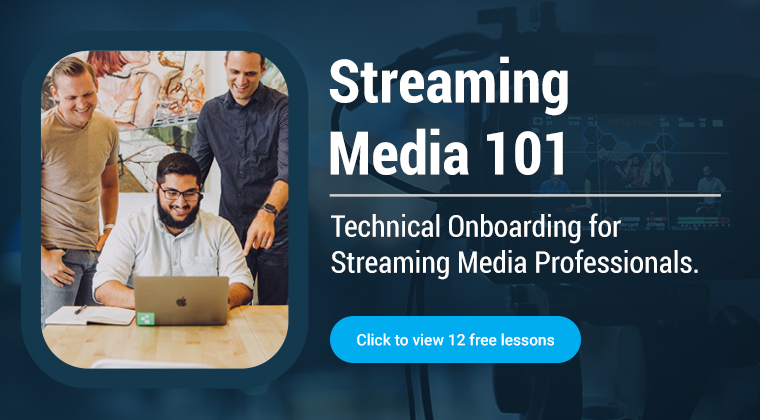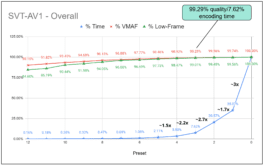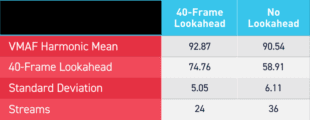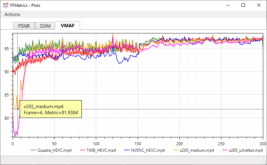Streaming Media West was a high-energy conference with a great vibe and the usual elegance of the Hyatt Regency Huntington Beach Resort & Spa. I gave two talks; a 3-hour preconference session entitled Advanced Codec Implementation & Production and a 45-minute session on Encoding AV1 with Open Source Alternatives. Below are the descriptions and links to the presentation downloads. W1. …
Read More »Choosing a Preset for SVT-AV1 and libaom-AV1
This article shows the quality/encoding time tradeoffs for producers choosing a preset for SVT-AV1 and libaom-AV1. Note to readers – 12/13 – AOM has released version 1.4, which fixed the SVT-AV1 preset issues reported in the first version of this article. Presets are the most important configuration option for controlling quality and throughput for most codecs. For this reason, when …
Read More »How to Compare Hardware Transcoders
This article details a methodology for comparing hardware transcoders considering cost/stream, watt/stream, and output quality. If you’ve ever benchmarked software codecs, you know the quality/throughput tradeoff; simply stated, the higher the quality, the lower the throughput. In contrast, for many first-generation hardware encoders, throughput was prioritized, but the quality was fixed; you got what you got. Finding the Key Quality …
Read More »Dense is good when it comes to transcoding
Back in high school, if someone called you dense, it meant you were slow on the uptake, and it definitely wasn’t a compliment. For high-volume video transcoding, however, density is, without question, a major plus. Some background. I now work with NETINT, a Canadian company that designs, develops, and sells ASIC-powered transcoders like the T408 and T432, which can output H.264 and …
Read More »Choosing a Live Transcoder
Four days on the show floor at IBC solidified the concept that your choice of the live encoder is dictated by your encoding application. In this article, I’ll review the types of encoders and the trade-offs associated with each type and will identify the type of encoder that works best for a few selected encoding applications. Types of Live Transcoders …
Read More »Installing and Using FFMetrics to Compute and Visualize VMAF, SSIM, and MS SSIM Metrics
This tutorial teaches you how to install and use FFMetrics, a free tool that lets you compute and visualize VMAF, SSIM, and PSNR on up to 12 files. Let me start this article by stating that the one program I couldn’t live without in my role as video tester and evaluator is the Moscow State University Video Quality Measurement Too …
Read More »Additions and Updates to Video Quality Metrics Course
New lessons detail how to use FFMetrics; updated lessons on what VMAF is, how to compute VMAF with FFmpeg, and how to interpret VMAF scores. Just a quick note to let you know about new additions and updates to our course, Computing and Using Video Quality Metrics: A Course for Encoding Professionals, which teaches encoding professionals how to choose and …
Read More »Google Chrome plays HEVC: What Does it Mean?
When I first heard that Google Chrome played HEVC, I checked the weather in Hades to determine if it had, in fact, frozen over. Reports were inconclusive. Then I started reaching out to colleagues and contacts whose opinions I value to get their reactions and thoughts. Many spoke on the record, and many didn’t. In this article, I’ll attempt to …
Read More »Streaming Veteran Jan Ozer Joins NETINT as ASIC Adoption Accelerates
I’m joining NETINT’s marketing team and will continue to write, speak, publish, and maintain and expand the courses at the Streaming Learning Center. Vancouver, BC – August 8, 2022 – NETINT Technologies today, announced the hiring of Jan Ozer in the role of Senior Director, Video Technology Marketing. In this position, Ozer will lead industry benchmarking, technical validation, content creation, and the development of product …
Read More »SLC Updates AV1 Encoding Course
The course Encoding with the AV1 Codec has been updated with new instructions for SVT-AV1 1.0 and FFmpeg/libaom-AV1. AV1 is a powerful codec but to optimize quality and performance, you have to choose the optimal preset and thread count and then navigate through obscure commands like auto-alt-ref, row-mt, tile columns/tile rows, and lag-in-frames. The course, Encoding with the AV1 Codec, provides …
Read More » Streaming Learning Center Where Streaming Professionals Learn to Excel
Streaming Learning Center Where Streaming Professionals Learn to Excel











